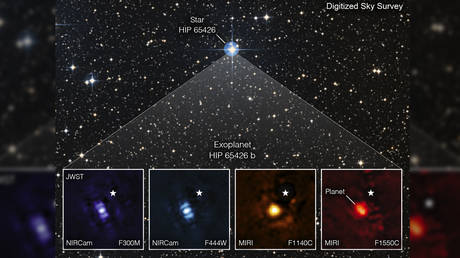Space-based telescope releases first photos of planet outside solar system
The scientific team behind the James Webb Space Telescope has released its first directly taken images of an exoplanet. source:TROIB RTS

NASA’s James Webb Space Telescope captured images of a massive Jupiter-like body 363 light years away
The James Webb Space Telescope has taken its first images of a planet outside our solar system. The young “super Jupiter” orbits its sun at a distance almost 100 times greater than that between Earth and the Sun.
NASA released images of the planet viewed through different filters in a blog post on Thursday. Scientific details of the observation were pre-printed in August and have yet to be peer reviewed.
The planet in question, dubbed HIP 65426 b, was first discovered by the Spectro-Polarimetric High-Contrast Exoplanet Research (SPHERE) in 2017, so the James Webb team knew exactly where to find it.
It is a gas giant that has a mass estimated to be between six and 12 times larger than Jupiter and is relatively young, dating back some 15 or 20 million years.
The planet travels around a star about 363 light years away from us. Its orbit is around 92 AU – a unit equal to the distance between Earth and the Sun – taking around 600 Earth years to complete a rotation.
That orbit distance is what helped the space observatory to take clear images of the exoplanet. Its optical sensors have special tools called coronagraphs, which can block radiation from a star and allow imaging of less bright objects nearby. The further a planet is from the star, the better its light can be eliminated.
READ MORE: Largest space telescope sustains ‘uncorrectable’ damage
The James Webb telescope photographed HIP 65426 b in several wavelengths that a ground-based observatory simply could not have picked due to Earth’s atmosphere. The SPHERE program captured images of it using short infrared light.












